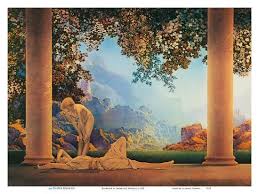Maxfield Parrish
Listen to the Recess! Clip
| Author | Rita Smith |
| Air Date | 7/25/2002 |

Maxfield Parrish Transcript
Maxfield Parrish was the most popular artist in America in the early decades of the 20th century. In a survey taken in 1925, Vincent van Gogh, Paul Cezanne and Maxfield Parrish were thought to be the three greatest artists of all time and throughout the 1920’s many a nursery wall was decorated with prints of his dreamscapes. One of his paintings of the 1920’s, “Daybreak,” which features two children in a classical setting with a mountainous background landscape, became a pop icon, selling more than 200,000 prints and becoming one of the most widely sold art prints in history.2
His paintings appeared in magazines, calendars, posters, greeting cards, and advertisements, as well as in books for both children and adults. The first children’s book he illustrated was L. Frank Baum’s Mother Goose in Prose in 1897 and he went on to illustrate The Arabian Knights, Graham Green’s Dream Days, Hawthorne’s Wonder Book and Eugene Field’s Poems of Childhood, all part of the Scribner Classics Series for children.
Parrish’s paintings and illustrations have an interesting mix of realism and fantasy. He has a photographic eye and pays attention to detail, but his work is imbued with a strong sense of romance. He manage to effectively combine such disparate elements as realism, fantasy, formal classical architecture and idealized dreamlike landscapes all in one painting. He paints an elegant dream world, bathed in those glowing singing colors, such as cobalt blue and deep purple, intimately associated with Parrish.
A contemporary reviewer of his illustrations in Poems of Childhood, noted that Parrish’s illustrations are particularly suited to the poems with their “childlike frankness, whimsical humor and delicate pathos,” but suggested that they also give a deeper meaning to them. Remember the poem from this book entitled “Wyken, Blynken and Nod?” Wynken, Blynken and Nod one night / Sailed off in a wooden shoe / Sailed on a river of crystal light / Into a sea of dew.
In the picture that accompanies the poem the mists that envelop the three little fishermen are “steeped with the mystic charm of childhood’s dreams, partly veiling, partly revealing the wonderful sights and the beautiful things on the ‘river of crystal light.’ It is more than an illustration,” the reviewer applauds, “It’s an illuminating interpretation.”
Sources:
Dalby, Richard. The Golden Age of Children’s Book Illustration, New York: Gellery Books, 1991.
Field, Eugene, Poems of Childhood, illustrated by Maxfield Parrish, New York: Charles Scribner’s Sons, 1904.